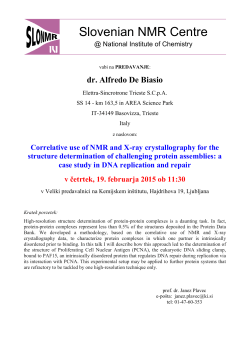
Document 448626
Chem 110 Homework #9 Name_____________________ 1. Consider the 19F NMR (spin 1/2; 100% na) spectrum of XeF5-. The isotopic abundance of 129Xe is 26.4%. Can you explain the splitting pattern seen below. 2. The figure below shows the 11B NMR spectra of a) THF.BH3 adduct and b) PhMe2P.BH3. Interpret the observed coupling patterns and mark on the figure where you would measure relevant coupling patterns. a) B-11 couples to 3 equivalent H nuclei to give a binomial quartet. A value of Jb-H can be measured between any pair of adjacent lines b) B-11 couples to 3 equivalent H nuclei to give a binomial quartet and couples to the P31 nucleus to give a doublet. The overall signal is a doublet of quartets. The coupling constants JBH and JBP can be measured between the pairs of lines in the spectrum 3. Predict the structure of SeH4 using VSEPR theory. Account for the fact that at 298K the 1H NMR spectrum of SeH4 shows a singlet but at 175 K the NMR spectrum shows that equal-intensity triplets observed. At low temp., seesaw SeH4 is stereochemically non-rigid fluxional. The H environments, axial and equitorial. Each axial H couples to 2 equatorial H's to give a binaomial triplet. Each equatorial H couples to 2 axial H to give a binomial triplet. At high temp, all H are chemically equivalent. Axial and Equitorial protons are exchanging rapidly and the single peak occurs in the center of the spectrum. 4. The compound [Mn(OH2)6]Cl2 is nearly colorless, while [Mn(OH2)6]Cl3 is brown with a color intensity typical of d->d transitions. Explain 5. Which of these has the highest frequency carbonyl stretching bands? You must explain why for full credit. a) Ni(CO)3(PH3) b) Ni(CO)3(PF3) PF3 ß Ni-CO so stronger CO bond c) Ni(CO)3(PCl3) d) Ni(CO)3(PMe3) PMe3 à Ni-CO so weaker CO bond due to more pi back bonding 6. Could you distinguish the following ions using magnetic susceptibility? Explain a) Cu2+ b) Cr3+ c) Tetrahedral Ni2+ d) Square-planar Ni2+ 7. The 1H NMR spectrum of (C5H5)2Fe(CO)2 shows tow peaks of equal area at room temperature but has four resonance of relative intensity 5:2:2:1 at low temperatures. Explain
© Copyright 2025





















